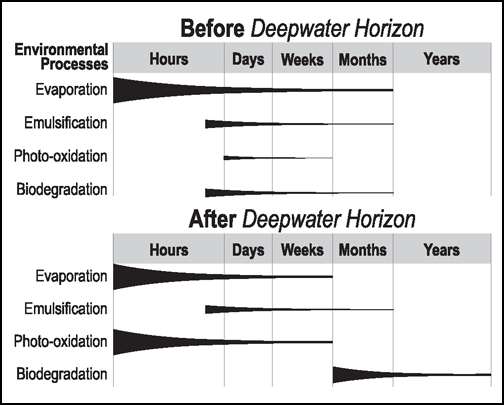Every resident on Earth shall rejoice in the Sun for it is loaded with benefits of all sorts: source of energy and vitamins for all beings, a magician that is indispensable in wielding photosynthesis, the sustainer of life on Earth with its warmth and capability to alter seasons.
But we wonder, what can be conspicuous ways of the Sun to exercise its power on this planet.
In a newsflash, a group of researchers from the Woods Hole Oceanographic Institution (WHOI) has unveiled another potential benefit of this resource and announced how a significant proportion of leaked oil on water surface can be dissolved into seawater through the action propelled by Sunlight.
The Deepwater Horizon disaster, an industrial mishap that is stated as the world’s largest marine explosion, helped us find that nearly 10 percent of the oil floating in the Gulf region got dissolved into seawater, something that has been called “photo-dissolution” for five decades.
What has become enlightening for us has been the influence of different wavelengths of light on photo-dissolution, crucial to ascertain the condition during oil spills.
This incident took 11 lives besides releasing huge 210 million gallons of crude oil in the Gulf of Mexico, but a disaster of the past has been used exploited here to understand processes better in present and future.
These findings got published under the name “Sunlight-driven dissolution is a major fate of oil at sea” in peer-reviewed journal Science Advances, bringing afore the role of sunlight that has been long forsaken in photo-oxidizing the surface oil.
What happens to Oil once it enters the marine environment?
Once the crude oil gets spilled into the ocean, it is ready to undergo weathering of all sorts: dissolution, evaporation, biodegradation, emulsification and photo- oxidation.
While many of these processes merely displace oil, others may transform it. For example, dissolution and evaporation render no alteration; biodegradation and photo- oxidation alter its chemical composition generating new compounds of different characteristics.
Similarly, the process of emulsification in water can only help alter physical characteristics of oil while keeping its chemical characteristics untouched.
Upon absorption of sunlight, the compounds in crude oil produce a wide range of reactive oxygen varieties including peroxy radicals or hydroxyl radicals, which can further oxidize other compounds in oil who cannot begin to react upon the incident sunlight and can only do so indirectly.

The million-dollar understanding of Nature’s Incline:
With major Oil spills happening quite often in the world with significant human footprint in every sector of its well-being, this finding has extended our understanding of where else is the oil disappearing into, and if this is indicative of something good or bad.
“If this sizable fraction of oil is being transformed by sunlight and is dissolving into seawater, that might mean that less oil is ending up in other places, like sensitive coastal ecosystems”.
“On the other hand, we have to consider the impacts of the compounds on marine organisms before we can decide if the net result is positive or negative”, explains the lead author of the study.
The study was undertaken using custom- made light-emitting diode (LED) reactors that helped measure penetration of oil that varied with different types of light, be it ultraviolet (UV), Infrared (IR) or visible light.
With hypothetical oil spill simulations created along with different types of light and varying oil thicknesses, times of the year, geolocations across the world etc.
“The importance of this process changes dramatically if you are looking at thin versus thick oil slicks. We also found, contrary to popular belief, that this process is relevant in Arctic waters, a particularly important finding given the expected increase in cargo ship traffic and heightened risk of spills in that region. This kind of modeling is critical when forecasting spills and considering the impacts on marine ecosystems.”
With wars, energy competition and control, oil spills can possibly be frequent in future. When Saudi’s state-owned Aramco’s major oil facilities could be infiltrated using drones by the Houthis operating in Yemen, what is not possible.

Secondly with climate change yielding a bigger hand in dynamics, greater warmth and earthly disturbances can trigger rumblings and subsequent spills, as happened in Peru.
Understanding this could also help determine the factors that could better control the process. The ways we can possibly respond, holds the key to a safe future.
However, it remains currently unknown about the potential toxicity of the compounds produced upon reaction with the sunlight and taming it, accordingly, that hopes to be worked upon and unraveled soon.
“While our findings suggest that a substantial fraction of surface oil can dissolve into the ocean after sunlight exposure, a logical next step is to evaluate its persistence and potential harm to aquatic animals”.


